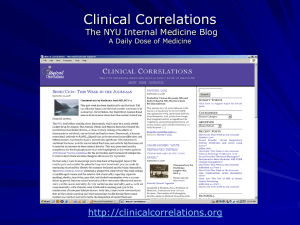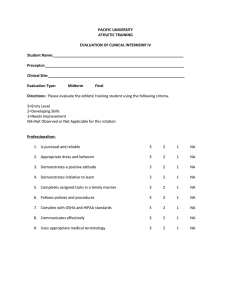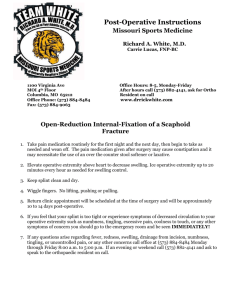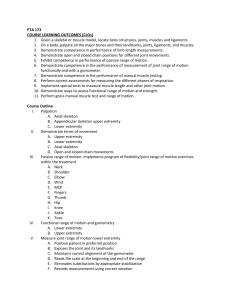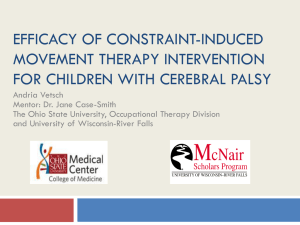1 improves functional use, conflicting evidence to support that it improves... moderate evidence that it improves perception of movement more than...
advertisement
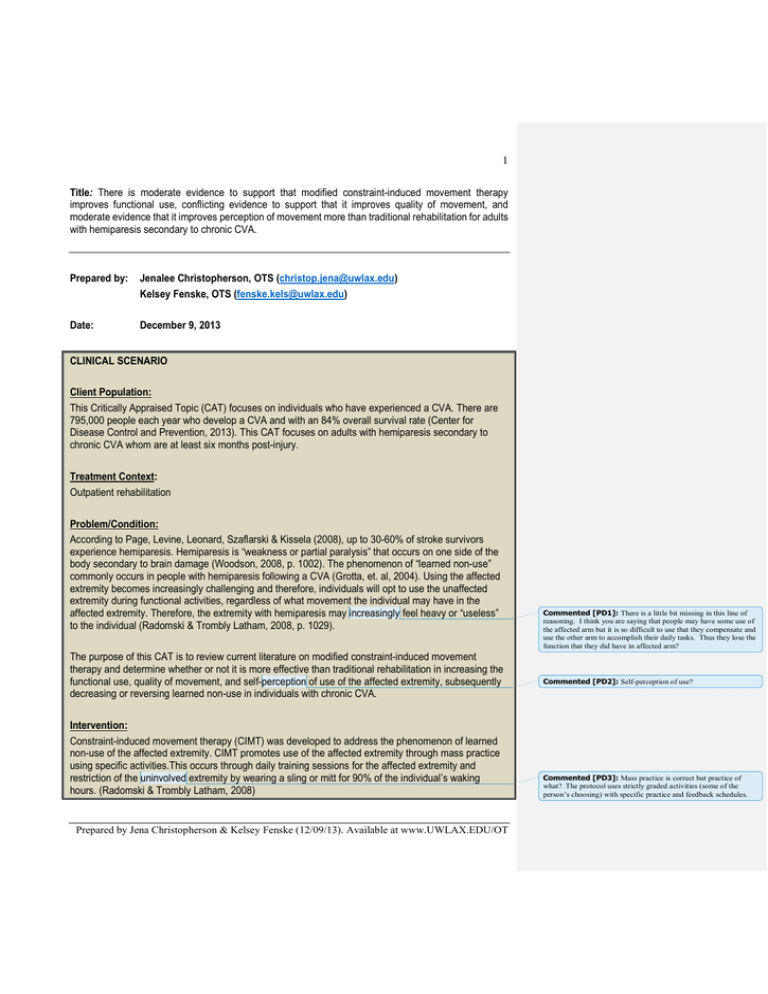
1 Title: There is moderate evidence to support that modified constraint-induced movement therapy improves functional use, conflicting evidence to support that it improves quality of movement, and moderate evidence that it improves perception of movement more than traditional rehabilitation for adults with hemiparesis secondary to chronic CVA. Prepared by: Jenalee Christopherson, OTS (christop.jena@uwlax.edu) Kelsey Fenske, OTS (fenske.kels@uwlax.edu) Date: December 9, 2013 CLINICAL SCENARIO Client Population: This Critically Appraised Topic (CAT) focuses on individuals who have experienced a CVA. There are 795,000 people each year who develop a CVA and with an 84% overall survival rate (Center for Disease Control and Prevention, 2013). This CAT focuses on adults with hemiparesis secondary to chronic CVA whom are at least six months post-injury. Treatment Context: Outpatient rehabilitation Problem/Condition: According to Page, Levine, Leonard, Szaflarski & Kissela (2008), up to 30-60% of stroke survivors experience hemiparesis. Hemiparesis is “weakness or partial paralysis” that occurs on one side of the body secondary to brain damage (Woodson, 2008, p. 1002). The phenomenon of “learned non-use” commonly occurs in people with hemiparesis following a CVA (Grotta, et. al, 2004). Using the affected extremity becomes increasingly challenging and therefore, individuals will opt to use the unaffected extremity during functional activities, regardless of what movement the individual may have in the affected extremity. Therefore, the extremity with hemiparesis may increasingly feel heavy or “useless” to the individual (Radomski & Trombly Latham, 2008, p. 1029). The purpose of this CAT is to review current literature on modified constraint-induced movement therapy and determine whether or not it is more effective than traditional rehabilitation in increasing the functional use, quality of movement, and self-perception of use of the affected extremity, subsequently decreasing or reversing learned non-use in individuals with chronic CVA. Intervention: Constraint-induced movement therapy (CIMT) was developed to address the phenomenon of learned non-use of the affected extremity. CIMT promotes use of the affected extremity through mass practice using specific activities.This occurs through daily training sessions for the affected extremity and restriction of the uninvolved extremity by wearing a sling or mitt for 90% of the individual’s waking hours. (Radomski & Trombly Latham, 2008) Prepared by Jena Christopherson & Kelsey Fenske (12/09/13). Available at www.UWLAX.EDU/OT Commented [PD1]: There is a little bit missing in this line of reasoning. I think you are saying that people may have some use of the affected arm but it is so difficult to use that they compensate and use the other arm to accomplish their daily tasks. Thus they lose the function that they did have in affected arm? Commented [PD2]: Self-perception of use? Commented [PD3]: Mass practice is correct but practice of what? The protocol uses strictly graded activities (some of the person’s choosing) with specific practice and feedback schedules. 2 The intensity of CIMT protocols have the potential to decrease the safety, independence, and compliancy for individuals receiving treatment. It is also difficult to convince third-party payers to reimburse these services (Radomski & Trombly Latham, 2008). Due to these complications, variations of CIMT have been developed, including modified constraint-induced movement therapy (mCIMT). Modified CIMT involves a less intensive protocol than CIMT by reducing the time and number of training sessions required and the amount of time the uninvolved extremity is restricted. (Radomski & Trombly Latham, 2008) Science Behind Intervention: Lipert et al. (1998) (as cited in Gillen, 2011) identified a cortical reorganization of the brain after individuals received CIMT treatment. This occurs due to the plastic properties of the brain. Before CIMT treatment, focal transcranial magnetic stimulation showed the affected extremity having a smaller representation in the motor cortex. After CIMT, the area became significantly larger and corresponded to the improvements experienced by the participants. This data suggests that CIMT can change and reorganize motor plans within the cortex. Occupational Therapy Application: Modified CIMT coincides with the goals and perspectives of occupational therapy. Individuals experiencing hemiparesis have significant difficulties performing bilateral activities of daily living. Modified CIMT functions as a preparatory activity in order to improve the functional use of the affected extremity secondary to CVA. This intervention addresses multiple concepts within the Occupational Therapy Framework including client factors, performance skills, performance patterns, and all areas of occupation. Modified CIMT has the capability of changing motor plans in the cortex of the brain, thus addressing body functions and structures. It also encourages mass practice of the affected extremity, improving the individual’s performance skills and allowing them to increase use of the affected extremity that they had prior to the CVA. Modified CIMT can also change habits and routines the individual may have developed in order to be successful in daily occupations, such as one-handed strategies. The uninvolved extremity is constrained during a large majority of the individual’s day, allowing for functional use of the affected extremity. Therefore, it can be incorporated into all daily occupations including activities of daily living, education, work, leisure, and social participation. Occupational Therapy Theory: Modified CIMT is based on theories of motor learning. Learned non-use negatively affects the individual experiencing hemiparesis, delaying functional recovery and motor planning (Grotta, et al., 2004). Motor learning proposes that continued mass practice of the affected extremity will lead to the development of new motor pathways, resulting in new motor behaviours (Jarus, 1994). The overall goal of motor learning is for the individual to be able to apply these new motor behaviours in a variety of contexts and situations (Jarus, 1994). Modified CIMT focuses on this motor re-learning process to allow for functional recovery of the affected extremity. International Classification of Functioning, Disability, and Health Level Application: Modified CIMT specifically works on the activity, participation, and body function and structures classification areas within the ICF. The increased use of the affected extremity within the mCIMT Prepared by Jena Christopherson & Kelsey Fenske (12/09/13). Available at www.UWLAX.EDU/OT Commented [PD4]: This needs a source Commented [PD5]: Based on what source? Commented [PD6]: So the science behind CIMT is twofold: one, as you say to increase the neuronal sprouting or unmask unused neurons to build new pathways to increase the movement in the affected arm. The other is by directing attention on the affected arm and forcing it’s use, the remaining function (strength, range, etc.) that is left in that arm can be developed and patterns of use are established instead of patterns of compensation with the other arm. 3 protocol will lead to a change in the body structures of the individual, as discusses previously. Together, body structures and activity changes have the potential to increase the individual’s participation in meaningful occupations. (World Health Organization, 2013) FOCUSED CLINICAL QUESTION: • Patient/Client Group: Adults with chronic CVA who have experienced hemiparesis and are at least six-months post-stroke. • Intervention: Modified constraint-induced movement therapy • Comparison Intervention: Traditional rehabilitation • Outcome(s): Functional use, quality of movement, and perception of movement of the affected extremity SUMMARY: Clinical Question: Is modified constraint-induced movement therapy more effective than traditional rehabilitation for adults with hemiparesis secondary to chronic CVA in improving functional use, quality of movement, and perception of movement of the affected upper extremity? Search: Five databases were searched resulting in eight articles that were relevant based on inclusion criteria. Three articles were chosen to be reviewed in this CAT based on the characteristics of the participants (focusing on individuals who were in the chronic phase of their CVAs), rigor, treatment protocols, methodology of the study, and publication date. These three articles comprised of one randomized controlled trial (Pedro score: 8/10), one low-quality randomized controlled trial (Pedro score: 5/10), and one quasi-experimental study. Findings of these studies indicates that modified constraintinduced movement therapy might be more effective in treating hemiparesis secondary to chronic CVA compared to traditional rehabilitation. CLINICAL BOTTOM LINE: There is moderate evidence that modified constraint-induced movement therapy improves functional use of the affected extremity, mixed evidence that it improves quality of movement of the affected extremity, and moderate evidence that it improves perception of movement of the affected extremity more than traditional rehabilitation for adults with hemiparesis secondary to chronic CVA. Limitation of this CAT: This critically appraised paper (or topic) has been reviewed by occupational therapy graduate students and the course instructor. Prepared by Jena Christopherson & Kelsey Fenske (12/09/13). Available at www.UWLAX.EDU/OT Commented [PD7]: Why did you select the lower quality RCT and quasi-experimental study over other RCT’s again? It isn’t clear from your sentence here 4 SEARCH STRATEGY: Table 1: Search Strategy Databases Searched Search Terms CINAHL Plus with full text Modified constraint-induced movement therapy Health Professions Database via EBSCOhost Modified constraint-induced movement therapy + CVA Cochrane Central Register of Controlled Trials PEDro Database OT Seeker Limits used Inclusion and Exclusion Criteria Inclusion English Language OR + Full Text AND mCIMT Modified constraint-induced movement therapy + chronic CVA Exclusion Modified constraint-induced movement therapy + chronic stroke Publication Date (2000present) Constraint-induced movement therapy Modified constraint-induced movement therapy + chronic stroke + function Modified constraint-induced movement therapy + chronic CVA + function RESULTS OF SEARCH Table 2: Summary of Study Designs of Articles Retrieved Level Level 1a Study Design/ Methodology of Articles Retrieved Total Number Located Source Citation Systematic Reviews or Metanalysis of Randomized Control Trials 1 Archives of Physical Medicine and Rehabilitation Shi, Tian, Yang & Zhao (2011) Prepared by Jena Christopherson & Kelsey Fenske (12/09/13). Available at www.UWLAX.EDU/OT 5 Level 1b Individualized Randomized Control Trials 4 Annals of Indian Academy of Neurology Singh & Pradhan (2013) Clinical Rehabilitation Brunner, Skouen & Strand (2012) Clinical Rehabilitation Lin, et al. (2007) Archives of Physical Medicine and Rehabilitation Wu, Chen, Tsai, Lin & Chou (2007) Physical Therapy Page, et al. (2008) Level 2a Systematic reviews of cohort studies 0 Level 2b Individualized cohort studies and low quality RCT’s (PEDro < 6) 1 Level 3a Systematic review of casecontrol studies 0 Level 3b Case-control studies and nonrandomized controlled trials 1 Physiotherapy Canada Siebers, Öberg & Skargren (2010) Level 4 Case-series and poor quality cohort and case-control studies 1 Physiotherapy Canada Stevenson & Thalman (2007) Level 5 Expert Opinion 0 STUDIES INCLUDED Table 3: Summary of Included Studies Study 1 Lin, et al. (2007) Study 2 Page, et al. (2008) Study 3 Siebers, Öberg & Skargren (2010) Design Randomized Control Trial (RCT) Low Quality RCT Quasi Experimental Level of Evidence Level 1b Level 2b Level 3b Prepared by Jena Christopherson & Kelsey Fenske (12/09/13). Available at www.UWLAX.EDU/OT 6 PEDro score 8/10 (only for RCT) 5/10 N/A Population Thirty-two individuals participated in this study. There were 21 men and 11 women (mean age: 57.89 years; range: 4381 years). It had been 13-26 months since experiencing their first CVAs (mean: 16.27). Inclusion criteria included: at least 12 months post CVA, neurologically stable, able to participate in mCIMT, Brunnstrom stage III or above in the proximal and distal parts of arm, non-use of affected extremity (Motor Activity Log amount-ofuse score <2.5), no balance issues, and no serious cognitive deficits, and no spasticity in the affected extremity. Participants were excluded from this study if they had a history of CVA or other neurological, neuromuscular, or orthopaedic diseases. Thirty-five individuals participated in this study. There were 22 men and 13 women (mean age: 57.9 years; range: 47-76). It had been 20-60 months since experiencing their first CVA (mean: 39.8 months). Twenty-three subjects had right hemiparesis and 12 had left hemiparesis. Inclusion criteria included: first CVA, active extension of at least 10 degrees of the MCP and IP joints and 20 degrees at wrist, 12 months post CVA, >69 on the mMMSE, between 1880 years old, and more affected arm non-use (<2.5 on the MAL). Participants were excluded if they had excessive spasticity, excessive pain in affected arm, current enrolment in a physical rehabilitation service, or current participation in experimental rehabilitation or drug studies. Twenty individuals participated in this study. There were 13 men and 7 women (median age: 54 years; range: 22-67). It had been 6 months-10 years since injury. Twelve participants had brain injuries resulting from cerebral vascular infarct and 8 had brain injuries resulting from cerebral vascular haemorrhage. Inclusion criteria included: reduced ability to use hemiparetic arm, at least 6 months post CVA, ability to actively extend wrist at least 20 degrees and MCP/IP to at least 10 degrees, no balance issues, minimum spasticity score of 1/5 on Modified Ashworth Scale for wrist and/or elbow flexors, no serious cognitive deficits, ability to understand training period, and motivation to participate. Individuals were excluded if they were experiencing any significant arm pain. Intervention Investigated Modified constraintinduced movement therapy Treatment included restriction of the unaffected hand for 3 weeks by placement in mitt for 6 hours/day and intensive training of the affected arm 2 hours/day for five days/week. Training included activities such Modified constraintinduced movement therapy Treatment included restriction of the unaffected arm for 10 weeks by placement in sling and mitt for 5 hours/day and half-hour therapy sessions for the affected arm 3 times per week during the 10week period. Shaping Modified constraintinduced movement therapy Treatment included restriction of the unaffected arm by a restriction belt for 90% of the individual’s waking hours for 7 days/week for 2 weeks and an individualized training program for 6 hours/day for two Prepared by Jena Christopherson & Kelsey Fenske (12/09/13). Available at www.UWLAX.EDU/OT 7 Comparison Intervention as picking up marbles, flipping cards, stacking blocks, combing hair, writing, and other activities performed in daily life. techniques were utilized during one-on-one treatment sessions, applied to activities such as writing or using a fork, which were chosen the participant in collaboration with the therapist. weeks. Individual training programs consisted of shaping, task practice, tailored exercises, and patient-specific tasks. Intensity was increased as the patient’s functional ability increased. Traditional rehabilitation Traditional rehabilitation treatment groups were matched for intensity and duration to the mCIMT group (therapy 2 hours/day and 5 days/week for 3 weeks). Traditional rehabilitation involved strength, balance, fine motor dexterity training, functional task practice, and stretching/weight bearing of affected arm. Traditional rehabilitation Traditional rehabilitation treatment groups were time-matched to the intensity and duration of the mCIMT group (halfhour therapy sessions 3 days/week). Approximately 80% of session included proprioceptive neuromuscular facilitation techniques and stretching within functional tasks if possible. The remaining time was focused on compensatory strategies, if applicable to the participant. N/A Control The participants in the control group received no therapy during the 10week period. Dependent Variables 1. Reaction time 2. Normalized movement time 3. Percentage of movement time where peak velocity occurs 4. Normalized movement unit 5. Maximum grip aperture 6. Percentage of movement time 1. Functional use 2. Quality of movement 3. Perception of movement 4. Limb function 1. Spasticity of elbow flexors 2. Spasticity of wrist flexors 3. Active range of motion 4. Grip strength 5. Functional use/perception of movement 6. Quality of movement 7. Hand function (grip function) Prepared by Jena Christopherson & Kelsey Fenske (12/09/13). Available at www.UWLAX.EDU/OT 8 where maximum grip aperture occurs 7. Functional use/ability 8. Quality of movement Outcome Measures 1-6. Kinematic analyses 7. Motor Activity Log and Functional Independence Measure 8. Motor Activity Log 1. Motor Activity Log 2. Fugl-Meyer Assessment of Motor Recovery 3. Motor Activity Log 3. Action Reach Arm Test 1-2. Modified Ashworth Scale 3. Goniometer 4. Dynamometer 5. Motor Activity Log 6. Box and Block Test 7. Sollerman Hand Function Test Results At post-testing, there was a statistically significant improvement reaction time and percentage of reach where peak velocity occurs. All other kinematic variables did not statistically improve. At post-testing, there were statistically significant improvements in perception of movement and functional use of the affected extremity in the mCIMT group when compared to both the TR and control groups. At post-testing, individuals with spasticity of the elbow and wrist flexors statistically improved both at posttesting and 6-month follow-up. Fugl-Meyer (Quality of Movement) Between TR & mCIMT Pre-test 1 = .12 Unable to calculate due to lack of information At post-testing, there was a statistically significant improvement in functional use, functional ability, and perception of movement of the affected extremity of the mCIMT group compared to the TR group. Effect Size MAL (Amount of Use) r = .67 Elbow-extension, wrist dorsiflexion, and grip strength improved There were not statistically significantly at statistically significant post-testing and 6-month improvements in quality of follow-up. movement of the affected extremity in the mCIMT group when compared to There was a statistically significant improvement both the TR and control in functional use and groups. quality of movement at post-testing and 6-month There were statistically follow-up. significant improvements in limb function in the There was a statistically mCIMT group compared significant improvement to the other two groups. in gross manual dexterity at post-testing and 6month follow-up. Prepared by Jena Christopherson & Kelsey Fenske (12/09/13). Available at www.UWLAX.EDU/OT 9 Conclusion Kinematic Analyses Reaction time: r = .38 Normalized movement time: r = .17 Percentage of peak velocity: r = .31 Normalized movement unit: r = .18 Maximum Grip Aperture: r = .28 Percentage of movement time where maximum grip aperture occurs: r = .29 MAL (Percentage of movement) r = .7 FIM r = .43 Pre-test 2 = .36 Between control & mCIMT Pre-test 1 = .22 Pre-test 2 = .43 Adults with chronic CVA only improved in two kinematic variables: reaction time and percentage of reach where peak velocity occurs. Perception of movement and functional use also improved for participants at post-testing. Future research should focus on incorporating task demands into mCIMT for task-specific training in stroke rehabilitation. Modified constraintinduced movement therapy was effective in improving participants’ functional use, perception of movement and limb function of the affected extremity in patients with chronic CVA. There were no significant improvements in quality of movement of the affected extremity. In addition, the length of time (10 weeks) this protocol required may cause concern whether it can be incorporated into therapy sessions. Further research should be done regarding the efficacy of shorter mCIMT protocols. Action Reach Arm Test Between TR & mCIMT Pre-test 1 = .86 Pre-test 2 = .87 Between control & mCIMT Pre-test 1 = .66 Pre-test 2 = .68 *Effect sizes for MAL could not be calculated due to lack of information After two weeks of mCIMT, participants had reduced spasticity, improved functional use and perception of movement, improved quality of movement of the affected extremity, and improved active range of motion and grip strength. This study indicates that mCIMT may be beneficial in reducing spasticity and improving functional use in individuals with chronic CVA. The design of this study limits its ability to generalize to the population, and therefore an experimental design will need to be administered to fully support the results of this study. Prepared by Jena Christopherson & Kelsey Fenske (12/09/13). Available at www.UWLAX.EDU/OT 10 IMPLICATIONS FOR PRACTICE, EDUCATION and FUTURE RESEARCH (Synthesis Section) Overall Conclusions For this CAT, the effects of mCIMT were investigated in relation to the improvement of functional use, quality of movement, and perception of movement of the affected upper extremity compared to traditional rehabilitation. Functional use is defined as the amount of time the affected arm is used when completing activities in daily living. Subjects who received mCIMT outperformed subjects who received traditional intervention with respect to functional use (Page, et al., 2008; Lin, et al., 2007). Siebers, Öberg & Skargren (2010) also found that modified CIMT was also found to improve functional use from pre- to post-testing within an intervention group. Moderate to large effect sizes were reported for functional use (Lin, et al., 2007). Siebers, Öberg & Skargren did not report effect sizes with regard to functional use and they could not be calculated due to lack of information. Quality of movement refers to the accuracy, gross manual dexterity, and coordination of the affected extremity. There were mixed results between the reviewed articles regarding improvements in quality of movement. Page, et al. (2008) determined that quality of movement of the affected extremity after mCIMT did not improve more than traditional rehabilitation. In addition, small effect sizes were calculated with regard to quality of movement (Page, et al., 2008). Siebers, Öberg & Skargren (2010) found statistically significant improvements in quality of movement after mCIMT. Perception of movement refers to the subjective experience of the individual as to how he or she is moving the affected extremity. Page, et al. (2008) and Lin, et al. (2007) both found also statistically significant improvements for perception of movement in the mCIMT group compared to the traditional intervention group. Lin, et al. (2007) reported moderate to large effect sizes for perception of movement. Siebers, Öberg & Skargren (2010) also found that modified CIMT was also found to improve perception of movement from pre- to post-testing within an intervention group. Small effect sizes were calculated for perception of movement (Page, et al., 2008). Effect sizes for Siebers, Öberg & Skargren (2010) could not be calculated due to lack of required parametric data. Although the three studies reached similar findings, the methodology of the studies were different. Protocol and treatment dosage varied amongst the research in duration, frequency, and intensity of mCIMT therapy received. Duration periods ranged from two to ten weeks; frequency of therapy ranged from three to five days per week; and intensity of therapy sessions ranged from half-hour sessions to six-hour sessions. Restriction protocols of the less affected extremity varied between the researches that could potentially affected outcomes. This ranged from subjects wearing restrictive device five hours to 90% of the participant’s waking hours. The device used to restrict the less affected arm differed amongst the studies, by using either a restrictive sling, mitt, or belt. The evaluations used to measure the dependent variables, functional use, quality of movement and perception of movement, were different amid the three studies. The Motor Activity Log (MAL), a subjective questionnaire, was used in all three studies to measure perception of movement. However, one study (Lin, et al., 2007) used the Functional Independence Measure (FIM) in addition to the MAL to measure functional use. Both measurements showed significant improvements in functional use; however the FIM showed a moderate effect size whereas the MAL results showed a large effect size. One study (Page, et al., 2008) measured quality of movement using the Fugl-Meyer Assessment of Motor Recovery (FM) while the Box and Blocks Test (BBT) was used in another study (Siebers, Öberg & Sargren, 2008). Lin, et al., 2008 did not include an outcome measure within their study that measured the dependent variable of quality of movement. Prepared by Jena Christopherson & Kelsey Fenske (12/09/13). Available at www.UWLAX.EDU/OT 11 The two experimental studies (Page, et al., 2008; Lin, et al., 2007) had comparison groups that were termed “traditional rehabilitation.” Therapy activities were similar in both groups. However, Page et al. (2008) included a third comparison group (the “control” group) in which participants did not receive any type of therapy. Statistical analyses were therefore compared between these three groups, whereas Lin, et al. (2007) only compared between two groups: traditional rehabilitation and modified constraintinduced movement therapy. Siebers, Öberg & Skargren (2010) did not compare the mCIMT group to any type of control group, and therefore only within-groups analyses were established. Therefore, findings of Siebers, Öberg & Skargren (2010) should be interpreted with caution, as there was not a control group involved in the study. Commented [PD8]: Have to be careful not to give this quasiexperimental study as much weight in this synthesis section as the other. The fact that they did not have a control group seriously throws their findings in doubt. Just go with the other two and then use this to confirm or to not differences. Boundaries: The studies reviewed in this CAT examined the effectiveness of mCIMT on adult subjects. Upon combining age ranges of all studies, this CAT examined an age range between 22 and 81 years. Participants in all studies were at least six months post-stroke, with a range of time of recovery between 6 and 60 months. A combined total of total of 79 subjects participated and of those, 50 participants received mCIMT. The effectiveness of mCIMT with other age ranges and in different stages of recovery post-stroke were not examined within this CAT. Each study had its own specific inclusion and exclusion criteria. For the purposes of this CAT, relevant inclusion criteria include the following: reduced use in the affected upper extremity, absence of cognitive impairments, and some volitional movement of the affected upper extremity. Two of the studies excluded individuals with excessive spasticity and the third (Siebers, Öberg & Skargren, 2010) included individuals with excessive spasticity. It is possible that including participants with spasticity had an impact on the findings of that particular study. All three studies excluded individuals if they were experiencing significant upper extremity pain. In addition to the relevant inclusion and exclusion criteria, it is important to address that there are differences between the mCIMT protocols and treatment times that were used in each of these studies. Therefore, this CAT cannot determine the optimal protocol and treatment times of mCIMT. Despite this, it is important to note that the outcomes of all three studies supported the efficacy of mCIMT to improve functional use and quality of movement of the affected extremity. Finally, findings of these studies should be interpreted with caution. Lin, et al. (2007) was the only randomized controlled trial that was included in this CAT. Page, et al. (2008) and Siebers, Öberg & Skargren (2010) were less rigorous studies. In addition, Siebers, Öberg& Skargren (2010) calculated non-parametric data for functional use and quality of movement. It may be possible that there were outliers that significantly impacted the results of the study, but this was not stated within the text. The lack of rigorousness in two of the studies should be presumed when interpreting the results of this CAT. Implications for Practice Research in mCIMT for a chronic CVA population shows promising implications for practice in improving functional use, quality of movement, and perception of movement of the affected extremity. However, research did not present a standardized protocol for treatment, which could create difficulties for therapists when attempting to implement mCIMT into treatment for people with chronic stroke symptoms. Despite differences in protocol amongst the studies, researchers in all studies indicated that mCIMT did help participants improve in the three dependent variables that were examined. With time constraints and productivity requirements that predominate today’s practice, therapists may be able to use a shorter and less intense mCIMT protocol and still improve a stroke survivor’s functional use of his or her affected extremity and quality of movement. Therapists should try to incorporate objective and occupation-based evaluations while using mCIMT to determine its overall ability to improve functional Prepared by Jena Christopherson & Kelsey Fenske (12/09/13). Available at www.UWLAX.EDU/OT Commented [PD9]: The amount of voluntary movement left is really important in mCIMT and CIMT studies. 12 use, quality of movement, and perception of movement of the affected extremity within the context of daily life. It is important to remain as client-centered as possible when choosing these occupations in order to increase compliance within this protocol. It would also be beneficial for therapists to use a subjective measure to understand their clients’ perceptions of the functional use of their affected upper extremities. Accordingly, future research should focus on objective and occupation-based outcome measures when addressing functional ability, quality of movement, and perception of movement of the affected extremity. Future research on modified constraint-induced movement therapy should also utilize experimental designs to increase the rigorousness and generalizability of this intervention, as well as establishing a standardized and evidence-based protocol for modified constraint-induced movement therapy. REFERENCES Critically appraised articles Lin, K.C., Wu, C.Y., Wei, T.H., Lee, C.Y., Liu, J.S. (2007). Effects of modified constraint-induced movement therapy on reach-to-grasp movements and functional performance after chronic stroke: A randomized controlled study. Clinical Rehabilitation, 21(12), 1075-1086. Page, S.J., Levine, P., Leonard, A., Szaflarski, J.P., & Kissela, B.M. (2008). Modified constraint-induced therapy in chronic stroke: Results of a single-blinded randomized controlled trial. Physical Therapy, 88(3), 333-340. Siebers, A., Öberg, U., & Skargren, E. (2010). The effect of modified constraint-induced movement therapy on spasticity and motor function of the affected arm in patients with chronic stroke. Physiotherapy Canada, 62(4), 388-396. Related articles (not individually appraised) Brunner, I. C., Skouen, J. S., & Strand, L. I. (2012). Is modified constraint-induced movement therapy more effective than bimanual training in improving arm motor function in the subacute phase post stroke? A randomized controlled trial. Clinical Rehabilitation, 26(12), 1078-1086. Shi, Y. X., Tian, J. H., Yang, K. H., & Zhao, Y. (2011). Modified constraint-induced movement therapy versus traditional rehabilitation in patients with upper-extremity dysfunction after stroke: a systematic review and meta-analysis. Archives of Physical Medicine and Rehabilitation, 92(6), 972-982. Singh, P. & Pradhan, B. (2013). Study to assess the effectiveness of modified constraint-induced movement therapy in stroke subjects: A randomized controlled trial. Annals of Indian Academy of Neurology, 16(2), 180-184. Stevenson, T., & Thalman, L. (2007). A modified constraint-induced movement therapy regimen for individuals with upper extremity hemiplegia.Canadian Journal of Occupational Therapy,74(2), 115-124. Wu, C. Y., Chen, C. L., Tsai, W. C., Lin, K. C., & Chou, S. H. (2007). A randomized controlled trial of modified constraint-induced movement therapy for elderly stroke survivors: changes in motor impairment, daily functioning, and quality of life.Archives of Physical Medicine and Prepared by Jena Christopherson & Kelsey Fenske (12/09/13). Available at www.UWLAX.EDU/OT Commented [PD10]: So far the FIM was mentioned in passing, but it was the functional measure used in these studies. Also, there was no mention of the actual activities that people did during the intervention protocol so they might have been occupation based? Commented [PD11]: So there were several articles that did use experimental designs that were not included in this CAT. Would they have shown something different? What did the systematic review show? 13 Rehabilitation, 88(3), 273-278. Sources cited American Occupational Therapy Association. (2008). Occupational therapy practice framework: Domain and process (2nd ed.). The American Journal of Occupational Therapy, 62, 625-683. Centers for Disease Control and Prevention. (2013). Stroke facts and statistics. Retrieved from http://www.cdc.gov/stroke/facts_statistics.htm. Gillen, G. (2011). Upper extremity function and management. Stroke rehabilitation: A functionbased approach. (pp. 218-280). St. Louis, MS: Elsevier Mosby. Grotta, J. C., Noser, E. A., Ro, T., Boake, C., Levin, H., Aronowski, J., & Schallert, T. (2004). Constraint-induced movement therapy. Stroke, 35, 2699-2701. Jarus, T. (1994). Motor learning and occupational therapy: The organization of practice. The American Journal of Occupational Therapy, 48(9), 810-816. Radomski M.V. & Trombly Latham C.A. (2008). Occupational therapy for physical dysfunction (6th ed). Pennsylvania: Lippincott Williams & Wilkins. Woodson A.M. (2008). Stroke. In M.V. Radomski and C.A. Trombly Latham (Eds.). Occupational therapy for physical dysfunction (6th ed., p. 1029). Pennsylvania: Lippincott Williams & Wilkins. World Health Organization. (2011). International classification of function and disability. Prepared by Jena Christopherson & Kelsey Fenske (12/09/13). Available at www.UWLAX.EDU/OT
